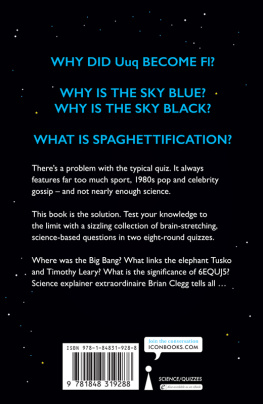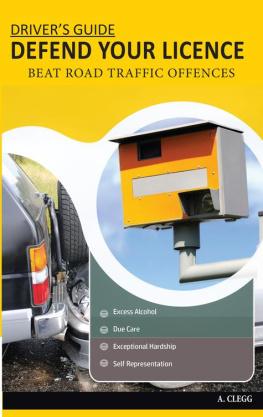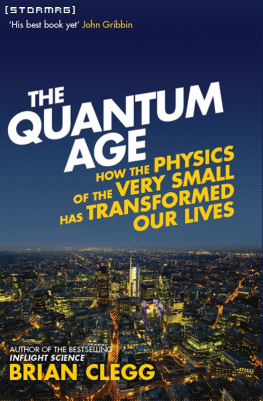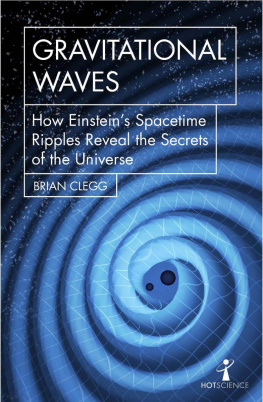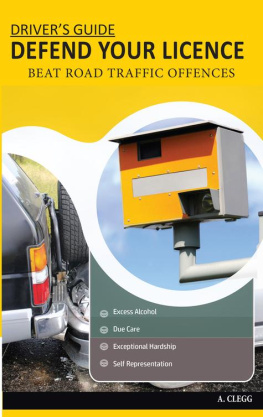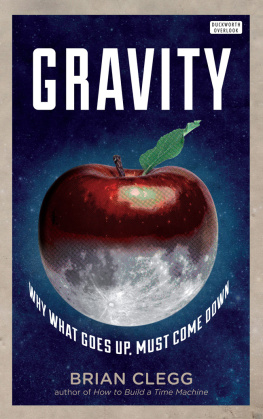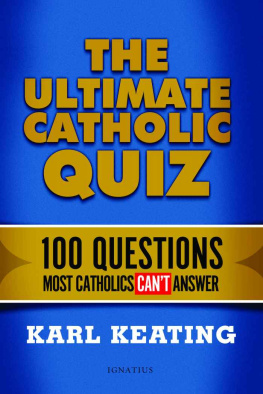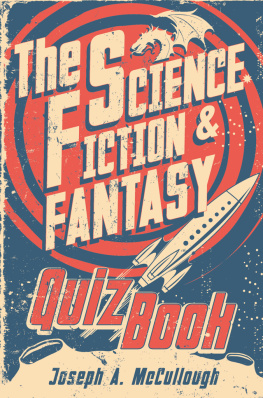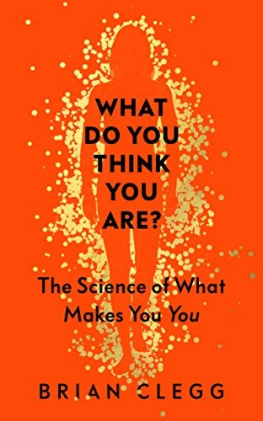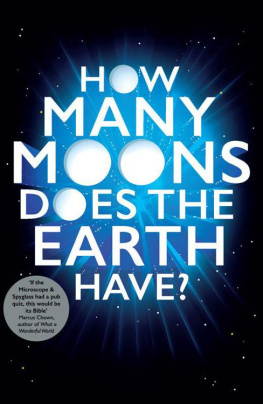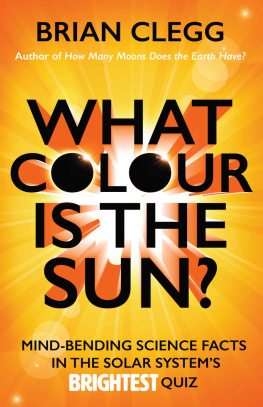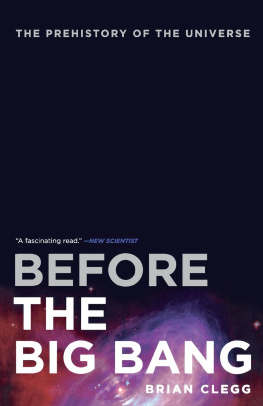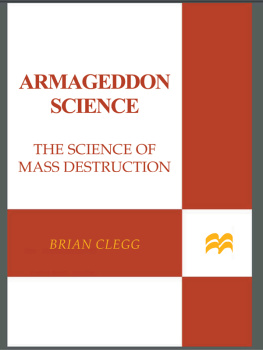HOW
MANY
MOONS
DOES THE
EARTH
HAVE?
Also by Brian Clegg
Dice World
Inflight Science
Introducing Infinity: A Graphic Guide
Light Years
Science for Life
The Quantum Age
The Universe Inside You
HOW
MANY
MOONS
DOES THE
EARTH
HAVE?
THE ULTIMATE SCIENCE
QUIZ BOOK
BRIAN CLEGG

Published in the UK in 2015 by
Icon Books Ltd, Omnibus Business Centre,
3941 North Road, London N7 9DP
email:
www.iconbooks.com
Sold in the UK, Europe and Asia
by Faber & Faber Ltd, Bloomsbury House,
7477 Great Russell Street,
London WC1B 3DA or their agents
Distributed in the UK, Europe and Asia
by TBS Ltd, TBS Distribution Centre, Colchester Road,
Frating Green, Colchester CO7 7DW
Distributed in the USA by
Publishers Group West,
1700 Fourth Street, Berkeley, CA 94710
Distributed in Canada by Publishers Group Canada,
76 Stafford Street, Unit 300
Toronto, Ontario M6J 2S1
Distributed in Australia and New Zealand
by Allen & Unwin Pty Ltd,
PO Box 8500, 83 Alexander Street,
Crows Nest, NSW 2065
Distributed in South Africa by
Jonathan Ball, Office B4, The District,
41 Sir Lowry Road, Woodstock 7925
ISBN: 978-184831-928-8
Text copyright 2015 Brian Clegg
The author has asserted his moral rights.
No part of this book may be reproduced in any form, or by any
means, without prior permission in writing from the publisher.
Typeset in PMN Caecilia by Marie Doherty
Printed and bound in the UK
by Clays Ltd, St Ives plc
For Gillian, Rebecca and Chelsea
ABOUT THE AUTHOR
Science writer Brian Clegg studied physics at Cambridge University and specialises in making the strangest aspects of the universe from infinity to time travel and quantum theory accessible to the general reader. He is editor of www.popularscience.co.uk and a Fellow of the Royal Society of Arts. His previous books include Science for Life, Light Years, Inflight Science, Build Your Own Time Machine, The Universe Inside You, Dice World, The Quantum Age and Introducing Infinity: A Graphic Guide.
www.brianclegg.net
ACKNOWLEDGEMENTS
With many thanks to my editor Duncan Heath, and everyone at the excellent Icon Books for their support. Most of all, for every pub quiz Ive ever taken part in and thought I wish there was more science.
INTRODUCTION
How Many Moons Does the Earth Have? has a traditional quiz format. The book contains two quizzes, each with six rounds of eight questions, plus two special rounds which earn up to ten points and involve themed questions.
Sometimes, though, the best way to enjoy a quiz is to test yourself, so the book is designed to be read through solo as well. Each answer is accompanied by illuminating information, so there is more to it than just getting the answer right. Of course, if youre using the book as a pub quiz, you dont need to include these parts.
If you are going to use the book in a quiz, youll need to copy the questions from the two special rounds and print out enough so that each team can have their own question sheet. You might like to use one of these as a table round, which is left on the teams tables to answer between the other rounds.
A popular addition in quiz play is to allow each team to have a joker to use on a round of their choice (before they see the questions), which doubles their points in that round.
The little factoids after each question are primarily for your enjoyment, but depending on your audience, it might add to the fun to read them out when running a quiz. And if a topic takes your interest, each question has a Further reading link to the book list at the back, to really delve into a subject.
However you use the book enjoy it!
QUIZ 1
ROUND 1: EARTH AND MOON
QUESTION 1
Counting moons
How many moons does the Earth have?
Answer overleaf
While youre thinking
Jupiter has at least 67 moons.

The largest moon in the solar system is Jupiters moon Ganymede, which has a radius of around 2,600 kilometres, more than one third the size of the Earth.

There is evidence already of moons around planets in other solar systems.
The Earth has one moon
This may seem an obvious answer to a ridiculously easy question, but viewers of TV show QI have been told that it isnt true. While the show has been on air, the number they have provided has varied from 0 to 18,000 but in reality, the obvious answer, 1, is the best.
The reason given for a large number is that lots of little lumps of rock get captured by Earths gravitational field for a few days and while captured are natural satellites, making them moons. The zero figure suggests that the Moon is a planet, not a moon, because it is unusually large compared with the Earth but this decision is arbitrary and is not accepted by the astronomical community. (And as the Moon it is just a moon.)
There is not as definitive a definition of moon as there is of planet, but there are still clearly intended consequences from using the word moon. These are that the body in question should be:
- Long-lasting I suggest staying in orbit for at least 1,000 years
- Sizeable say at least 5 kilometres across
This would still allow moon status for the pretty dubious companions of Mars, Phobos and Deimos, which are about 20 kilometres and 10 kilometres across.
Clearly such rules are implied when we talk about moons. If the time rule didnt exist, then every meteor that spent a few seconds passing through our atmosphere would be a moon, while without the size rule, we would have to count every tiny piece of debris in Saturns rings as a moon each is, after all, a natural satellite.
Further reading: Near-Earth Objects
QUESTION 2
Space Station blues
Weve all seen astronauts floating around pretty much weightless on the International Space Station. What percentage of Earth normal is the gravity at the altitude of the ISS?
Answer overleaf
While youre thinking
The first part of the International Space Station was launched in 1998.

The orbit of the ISS varies between 330km and 435km above the Earth call it 350km for this exercise.

One of the favourite sections of the ISS for astronaut photographs is the Cupola, an observatory module that has been likened to looking out of the Millennium Falcon in Star Wars.
At the ISS, gravity is around 90 per cent Earth normal
Allow yourself a mark for anything between 88 and 92 per cent. Newton gives us a value for the gravitational attraction (F) between two bodies as: F=Gm1m2/r2.
We can use this to work out the difference between the ground and the ISS. Luckily, practically everything cancels out. G (gravitational constant) is the same, m1 (the mass of the Earth) is the same and m2 (the mass of a person) is the same. So the ratio of the gravitational forces ForceISS/ForceEarth is just r2Earth/r2ISS, where rEarth is the distance from the Earths centre to its surface and rISS the distance from the Earths centre to the ISS.
Next page
